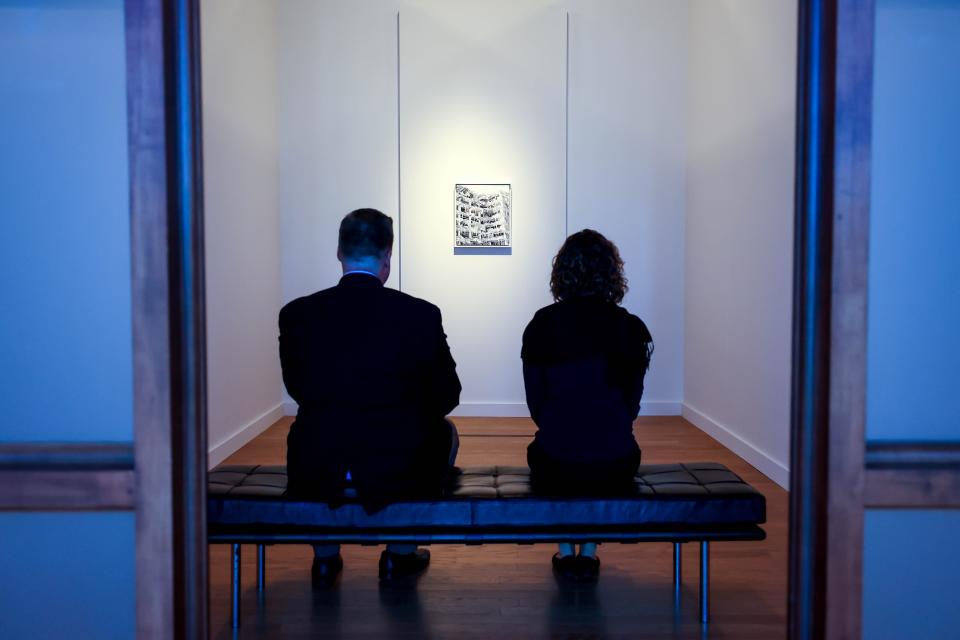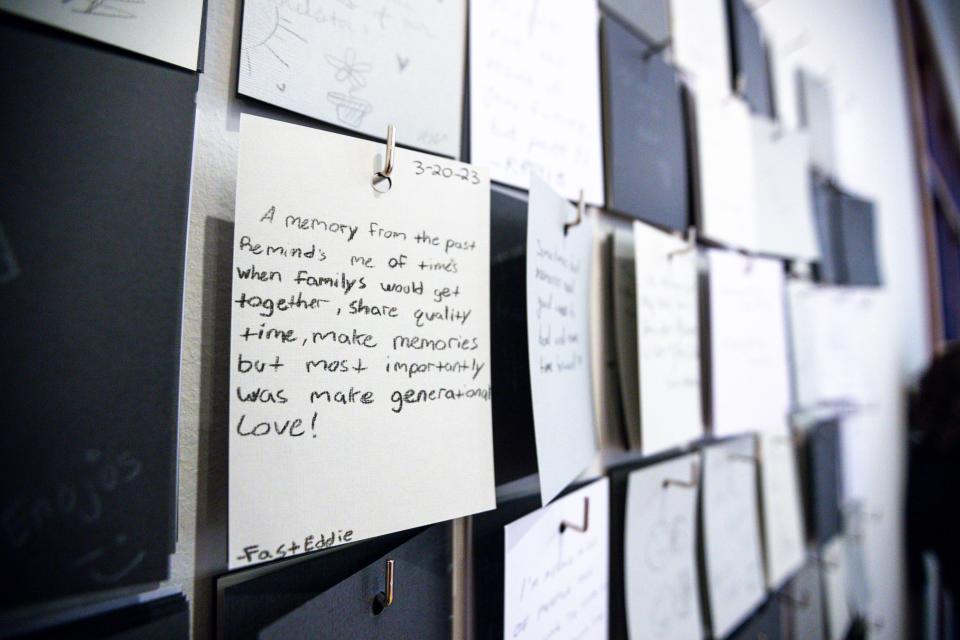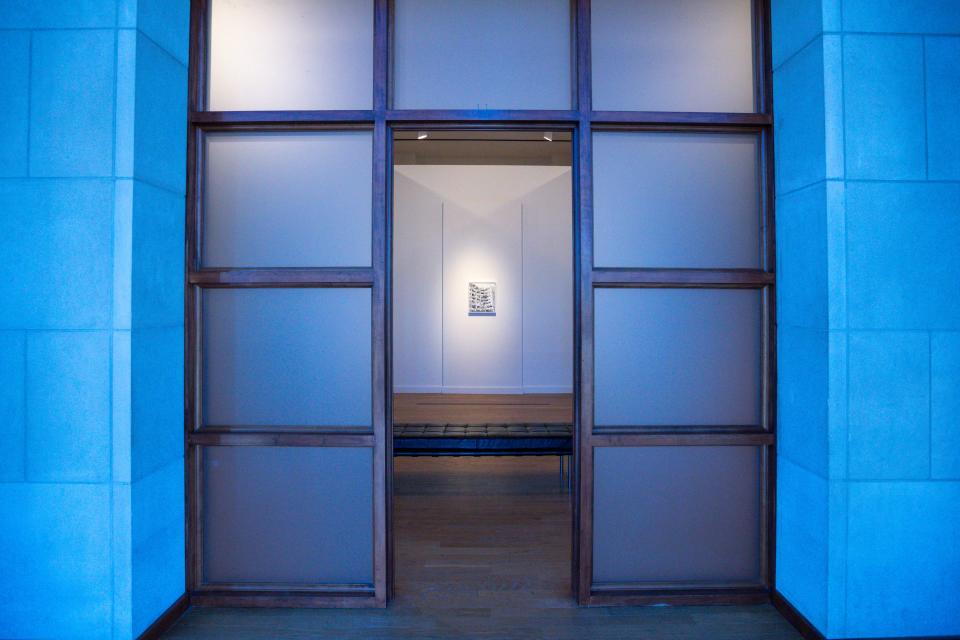A Baltimore artist's painting of the Oklahoma City bombing comes home to downtown OKC
- Oops!Something went wrong.Please try again later.
Cynthia Daignault was a high school senior in Maryland when a bomb destroyed the Alfred P. Murrah Federal Building in downtown Oklahoma City at 9:02 a.m. April 19, 1995.
Although she was about 1,300 miles away when the blast left 168 people dead and more than 500 injured, the tragedy reverberated deeply within her as a Baltimore teenager.
"There's just a poignancy to memory of that time period, like the way that the music we were listening to senior year is still so emotionally resonant. Everything is so visceral, like your first love and your first heartbreak and the music you listen to — and what's going on in the world," Daignault told The Oklahoman.
"Those become things that, I think, really lock in, in a way that we see them incredibly clearly. ... You're thinking about joining the adult world and what that means at this moment, and then the adult world really crashes on your doorstep in a pretty intense way."

Oklahoma City bombing: The names and faces of victims
Now an artist, Daignault channeled her lasting memories of the bombing into her 2021 oil painting "Oklahoma," an abstracted gray-and-white depiction of the wrecked Murrah Building. Now a part of the Oklahoma City Museum of Art's permanent collection, her painting was put on display for the first time in downtown OKC ahead of the 28th anniversary of the bombing in an unusual single-painting exhibit.
"It is absolutely unusual to have an exhibition of one painting, and it was really very much about creating a space where people could sit and contemplate it and look at it, to be alone with it or be with friends with it," said Rosie May, the museum's director of curatorial affairs and audience engagement.
"We wanted to make sure we were giving it the weight it would have in this community ... especially just blocks from the site of the Murrah Building."

What does the painting look like and how is it displayed?
A black wall with the words "Cynthia Daignault: Oklahoma" emblazoned in large, white letters greets visitors to the second-floor gallery of the Oklahoma City Museum of Art where the painting is displayed.
Before they glimpse the painting, museumgoers encounter an essay about the work and two quotes from the artist. One reads, "I have hopes that the remembrance of things past is something that brings us together. This is a shared history and in collective trauma there is a connection that binds us all."
The other reads, "Making this work now is an act of remembrance, of living back in that moment and connecting to what it means for us today."
Exhibited in a snug alcove created by three white-painted walls, visitors first see Daignault's small painting from a distance, where a bench invites them to sit several feet away if they choose. Or, they can walk to the black line on the floor and examine the instantly recognizable painting up close.
Look back: A timeline of the Oklahoma City bombing and beyond
At a small writing desk inside the exhibit, a set of black, white and gray note cards and matching pencils are provided. Visitors are invited to draw or write their thoughts on "How does remembering the past bring people together?"
"I wanted to give people an opportunity to respond and reflect with a prompt based on what Cynthia was doing, as an outlet," said May, an Oklahoma native.
"If you are presenting a difficult subject in a museum, one that will evoke strong emotions in people ... and you're not giving them some sort of escape valve ... they'll just feel upset. But if you give them an opportunity to reflect, share and hope — and that's what this painting for Cynthia is all about — it reminds us that in shared trauma, there's an opportunity for us to bring people together and create a better future."

Why did the museum staff wait two years to exhibit the painting?
The Oklahoma City Museum of Art acquired Daignault's "Oklahoma" with funds from an Oklahoma City Community Foundation grant in honor of the community volunteers who assisted in the recovery from the 1995 bombing.
Jennifer Klos, a former OKC Museum of Art curator now based in Texas, contacted the staff about the painting after spotting it at the 2021 TWO x TWO for AIDS and Art, a large annual charity art auction in Dallas.
"It seemed a really appropriate thing for us to acquire because it was inspired by the photograph of the destroyed Murrah Building ... that made the front page of every major newspaper probably in the world," May said. "So, we acquired it, and then there was a discussion of where to put it and what to do with it."
Considering the sensitive nature of the work, OKC Museum of Art staffers knew that special care had to be taken in exhibiting the painting.
"This will always be a part of our collection, so I think for us, it was important to present it in a very thoughtful and isolated way the first time that we're showing it," said OKC Museum of Art President and CEO Michael Anderson, adding that the painting will be exhibited on its own through the end of the year.
Oklahoma City bombing : Survivors share their stories of the aftermath
"We'll show it many, many more times moving forward, and it probably will be shown in different contexts. But I think the image itself is so visceral that people who are familiar with our collection that are coming here not expecting this, we needed to do something different with it the first time."
For May, creating the single-painting exhibit meant making her first visit to the Oklahoma City National Memorial & Museum and consulting with staff there.
"I think that art after the events in 1995 was a means of healing, and it's played a large role in our story. ... So, I think it is a unique opportunity to talk about the role art has in dealing with traumatic events," said Stephen Evans, the national memorial's director of education and public programming.
"It's easy to focus on the impact it had in Oklahoma City. But we have people who come from Germany, from Vietnam, to the museum and say, 'I remember where I was on April 19, 1995, and this is its impact on me.' It was a global event — maybe like nothing will ever be in the future, just because of the way media works and worked back in 1995. I'm from New York; I remember where I was. The impact that had on my entire generation across the country was massive."

How did an 'Oklahoma' painting by a Baltimore artist end up in OKC?
The Oklahoma City bombing was the deadliest act of terrorism in U.S. history until Sept. 11, 2001. It remains the deadliest act of domestic terrorism in U.S. history.
Even after she graduated high school, the bombing continued to haunt Daignault. When she assisted artist Kara Walker on her "A Subtlety or the Marvelous Sugar Baby," a landmark, large-scale contemporary artwork about white supremacy, the project involved delving into what Oklahoma City bomber Timothy McVeigh wrote and read.
"When I was making 'Light Atlas,' which is a seminal piece of mine, I ended up staying in the hotel room where he planned the attack — and not on purpose," Daignault said. "It just so happened while I was traveling the country making that piece ... so it became a real touchstone."
In 2018, she embarked on a series of paintings called "What Happened" to chronicle the last 100 years of American history and culture. She knew that the Oklahoma City bombing would represent 1995 in her series, and in 2021, she created her "Oklahoma," working from the iconic photograph that The Associated Press sent out worldwide of the Murrah Building in 1995.
Oklahoma City bombing: OKC Philharmonic honors anniversary with milestone new album
"The cultural moment that we grew up in and the way that media functioned — it was pre-internet, obviously — I think you remember how ... whether we're talking about the O.J. Simpson chase or Desert Storm or the Oklahoma City bombing, those really were moments where everyone stopped and was looking at the same thing," she said.
"I think to understand just how deep of an impression some of those events made on people our age — the Challenger explosion, these touchstone media events that defined our lives — you have to have lived through that moment. ... It is different now how quickly things move through the news cycle."
As heavy as the subject matter of "Oklahoma" was, Daignault knew the painting was destined to end up in an institution rather than a private home, and she wanted it to be sold through a benefit.
But she had no idea the painting eventually would find its home in Oklahoma City.
"No one really had any idea that it would end up in Oklahoma City, at that museum, and when I found that out, I was very humbled and moved," she said. "I couldn't have been happier with the placement, as far as where it ended up. ... That's not something that I had any control over, but I can sort stand back in awe like, 'Wow, this is a beautiful thing that happened.'"
This article originally appeared on Oklahoman: A Baltimore artist's Oklahoma City bombing painting finds an OKC home

